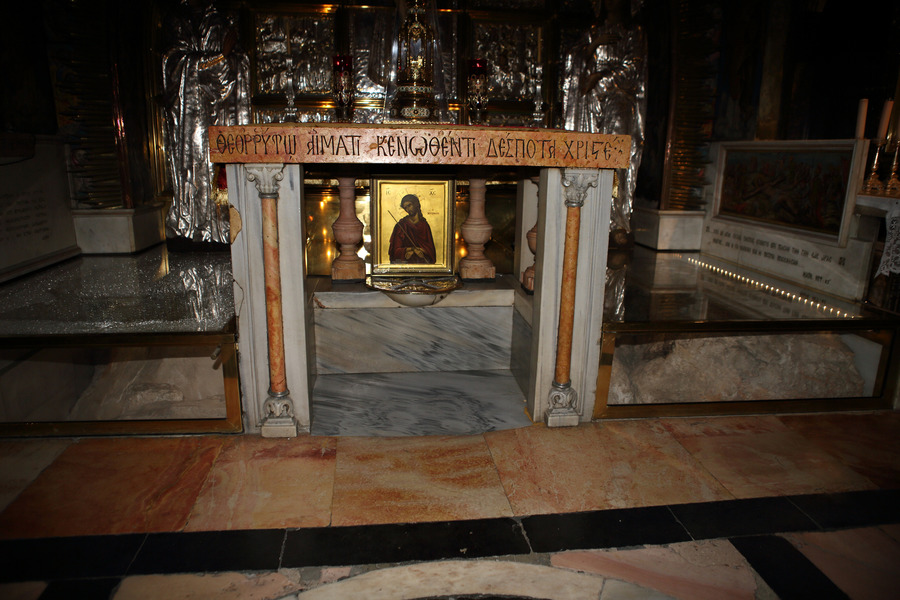Church of the Holy Sepulchre: Origins and Importance
Jerusalem is divided into four quarters: the Muslim quarter, the Christian quarter, the Jewish quarter, and the Armenian quarter. When focusing on the northwest Christian quarter, it is impossible to miss the historically significant structure called the Church of the Holy Sepulchre. The Church of the Holy Sepulchre is not only a large attraction, but it is believed it was built on the site of Jesus’ crucifixion and his burial. A church was first built on this site by Constantine the Great in about 336 CE, but it has been burned, restored, destroyed, and rebuilt many times since then, with the current architecture primarily dating from 1810.
The site of this church has a rich history, and it continues to be a sacred place for people around the world to this day. It has exceptional importance to the Christians living in Jerusalem, with a woman who currently lives in Jerusalem (as of 2013) stating, “‘This church is very special to me. Sometimes I see people who have dreamed their whole life of coming here, and I realize how lucky I am to live in Jerusalem. I can come to the church any time I want to touch the rock of Golgotha where we believe Jesus died on the cross and visit the tomb where he was buried and three days later rose from the dead” (Jerusalem 2013, 26:31). This large church site holds artifacts such as the believed location where Jesus died called the Rock of Calvary, enclosed in glass at the Altar of the Crucifixion which is the most visited area of the church. There are also many other things to see at the Church of the Holy Sepulchre, such as the Immovable Ladder, the Stone of Anointing, and the Golgotha. In addition to the physical representations of its history, the Church of the Holy Sepulchre still serves as an important geographic location. As mentioned by the movie Jerusalem 2013, it ends the procession taken by pilgrims on Good Friday as they walk the path Jesus took on his way to his Crucifixion.
When looking deeper into the history of the Church of the Holy Sepulchre, the reliability of the sources used to determine the significance of this location must be questioned. As Howell and Prevenier point out, “no source, and no interpretation of it, is perfectly reliable.” (Howell and Prevenier 2001, pg. 2). Knowing this, there are currently many historical relics located in and around the Church of the Holy Sepulchre, but whether or not this is the actual location of the crucifixion and burial of Jesus is debated. It is possible that Christians in the early centuries did not authentically preserve the location of these events, even though most known sources point to that spot. When looking to answer this question, archaeologists went under the ground of the church and recovered ancient graffiti, one example of which was a Latin inscription reading “Oh Lord, we have come,” with a date from over 1700 years ago, suggesting that Christians worshiped in this area even before the church was built. Additionally, archaeologists found ancient tombs believed to be from a Jewish cemetery. All of these sources combined with recorded history have led present-day members of Jerusalem to believe the Church of the Holy Sepulchre is the precise sacred location of many historical events in the life and death of Jesus. Ultimately, historians cannot concretely prove these beliefs, as sources alone do not tell the full story of history, but Christians in Jerusalem rely on faith and the physical evidence that is present to continue believing in the significance of their sacred church.
Citations:
https://www.youtube.com/watch?v=iLW6vO-7rFk
https://www.britannica.com/place/Holy-Sepulchre
:max_bytes(150000):strip_icc()/CHS_overview2-5a65df8beb4d52003773be25.jpg)


Really nice blog post that focuses on the Church of Holy Sepulchre, but within the context of the film we watched and the article we read about writing (creating) history. Well done!
ReplyDeleteSuggestion: you might want to make your photos larger in future posts so they fit better on the computer screen; you should also include captions and citations for the photos.